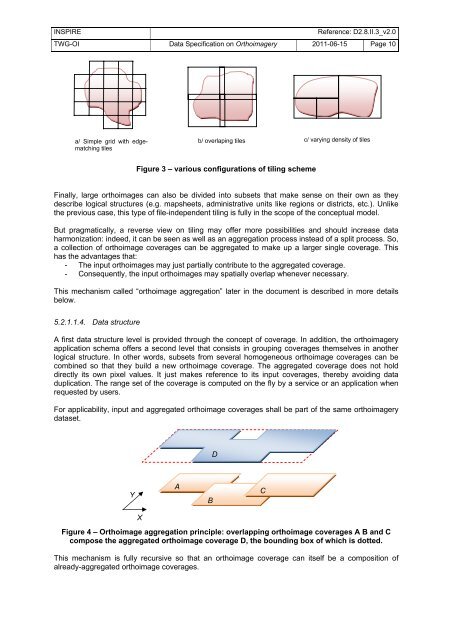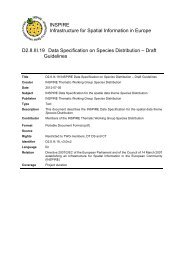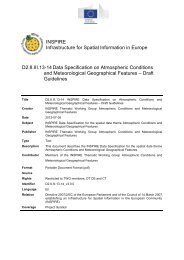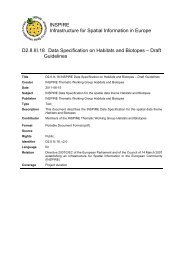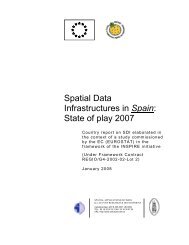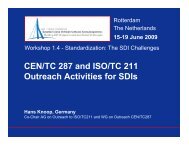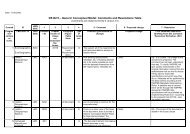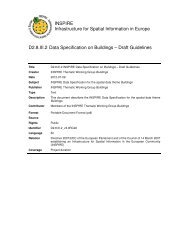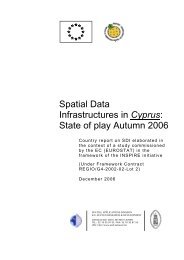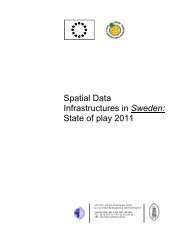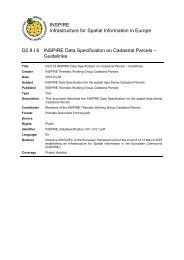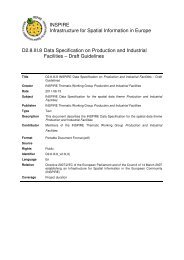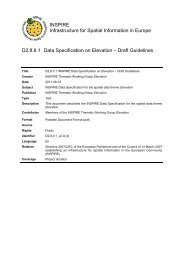Data Specification on Orthoimagery – Draft ... - INSPIRE - Europa
Data Specification on Orthoimagery – Draft ... - INSPIRE - Europa
Data Specification on Orthoimagery – Draft ... - INSPIRE - Europa
You also want an ePaper? Increase the reach of your titles
YUMPU automatically turns print PDFs into web optimized ePapers that Google loves.
<strong>INSPIRE</strong> Reference: D2.8.II.3_v2.0<br />
TWG-OI <str<strong>on</strong>g>Data</str<strong>on</strong>g> <str<strong>on</strong>g>Specificati<strong>on</strong></str<strong>on</strong>g> <strong>on</strong> <strong>Orthoimagery</strong> 2011-06-15 Page 10<br />
a/ Simple grid with edgematching<br />
tiles<br />
Figure 3 <strong>–</strong> various c<strong>on</strong>figurati<strong>on</strong>s of tiling scheme<br />
Finally, large orthoimages can also be divided into subsets that make sense <strong>on</strong> their own as they<br />
describe logical structures (e.g. mapsheets, administrative units like regi<strong>on</strong>s or districts, etc.). Unlike<br />
the previous case, this type of file-independent tiling is fully in the scope of the c<strong>on</strong>ceptual model.<br />
But pragmatically, a reverse view <strong>on</strong> tiling may offer more possibilities and should increase data<br />
harm<strong>on</strong>izati<strong>on</strong>: indeed, it can be seen as well as an aggregati<strong>on</strong> process instead of a split process. So,<br />
a collecti<strong>on</strong> of orthoimage coverages can be aggregated to make up a larger single coverage. This<br />
has the advantages that:<br />
- The input orthoimages may just partially c<strong>on</strong>tribute to the aggregated coverage.<br />
- C<strong>on</strong>sequently, the input orthoimages may spatially overlap whenever necessary.<br />
This mechanism called “orthoimage aggregati<strong>on</strong>” later in the document is described in more details<br />
below.<br />
5.2.1.1.4. <str<strong>on</strong>g>Data</str<strong>on</strong>g> structure<br />
A first data structure level is provided through the c<strong>on</strong>cept of coverage. In additi<strong>on</strong>, the orthoimagery<br />
applicati<strong>on</strong> schema offers a sec<strong>on</strong>d level that c<strong>on</strong>sists in grouping coverages themselves in another<br />
logical structure. In other words, subsets from several homogeneous orthoimage coverages can be<br />
combined so that they build a new orthoimage coverage. The aggregated coverage does not hold<br />
directly its own pixel values. It just makes reference to its input coverages, thereby avoiding data<br />
duplicati<strong>on</strong>. The range set of the coverage is computed <strong>on</strong> the fly by a service or an applicati<strong>on</strong> when<br />
requested by users.<br />
For applicability, input and aggregated orthoimage coverages shall be part of the same orthoimagery<br />
dataset.<br />
Y<br />
X<br />
A<br />
b/ overlaping tiles<br />
B<br />
D<br />
c/ varying density of tiles<br />
Figure 4 <strong>–</strong> Orthoimage aggregati<strong>on</strong> principle: overlapping orthoimage coverages A B and C<br />
compose the aggregated orthoimage coverage D, the bounding box of which is dotted.<br />
This mechanism is fully recursive so that an orthoimage coverage can itself be a compositi<strong>on</strong> of<br />
already-aggregated orthoimage coverages.<br />
C


